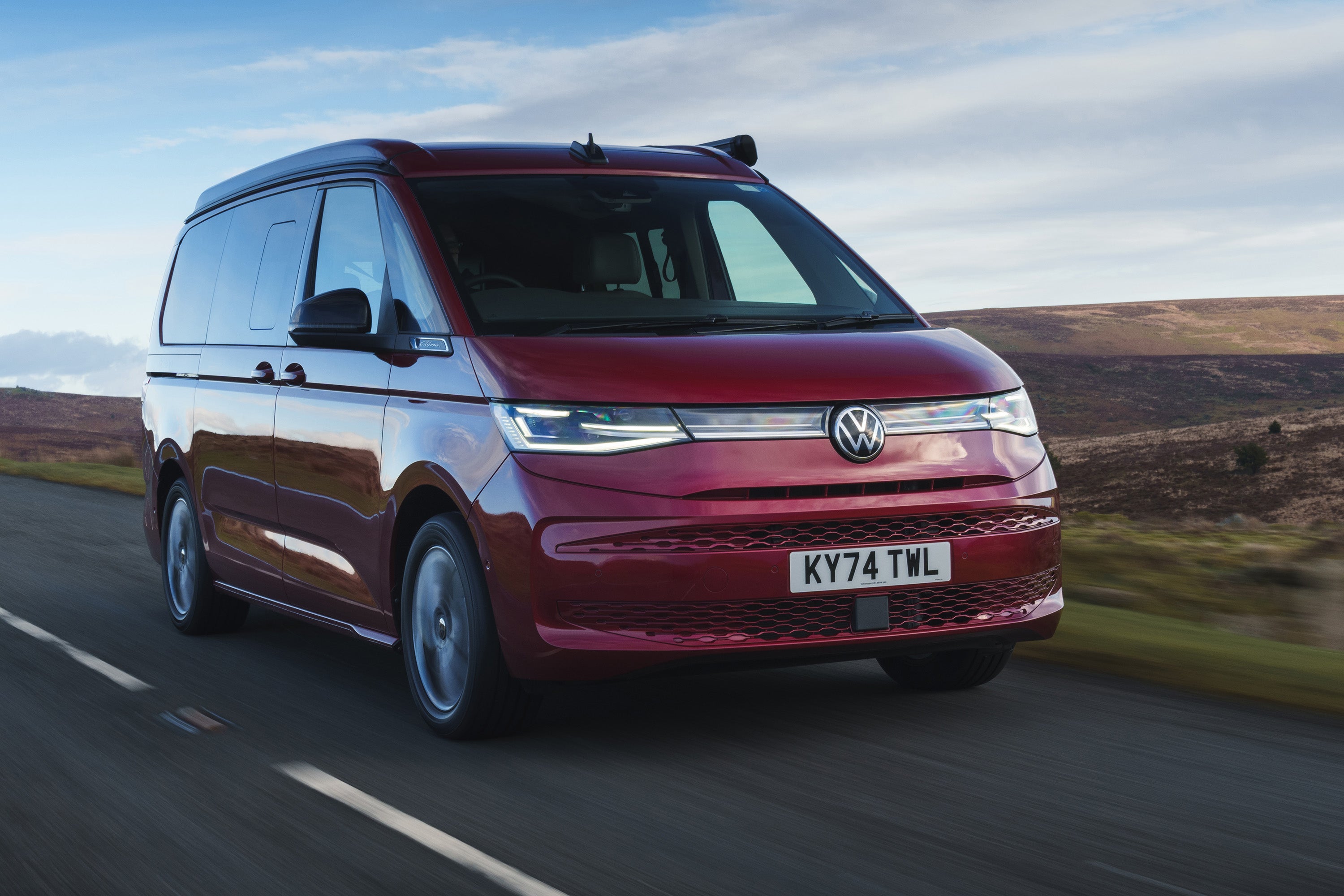Volkswagen California Review 2025: Price, specs & boot space
Written by Phil Hall
Quick overview
Pros
- Space for four to sleep in comfort
- Easy to drive and used daily if needed
- Plush and well-designed interior
Cons
- Camper control screen not that responsive
- More expensive than ever, but it should hold its value
- Smaller kitchen than before
Verdict: Is the Volkswagen California a good campervan?
"There's a reason why campsites are dominated by VW campers, and the latest T7 California looks set to continue that trend. It's pricey, but it's the best all-round campervan going."
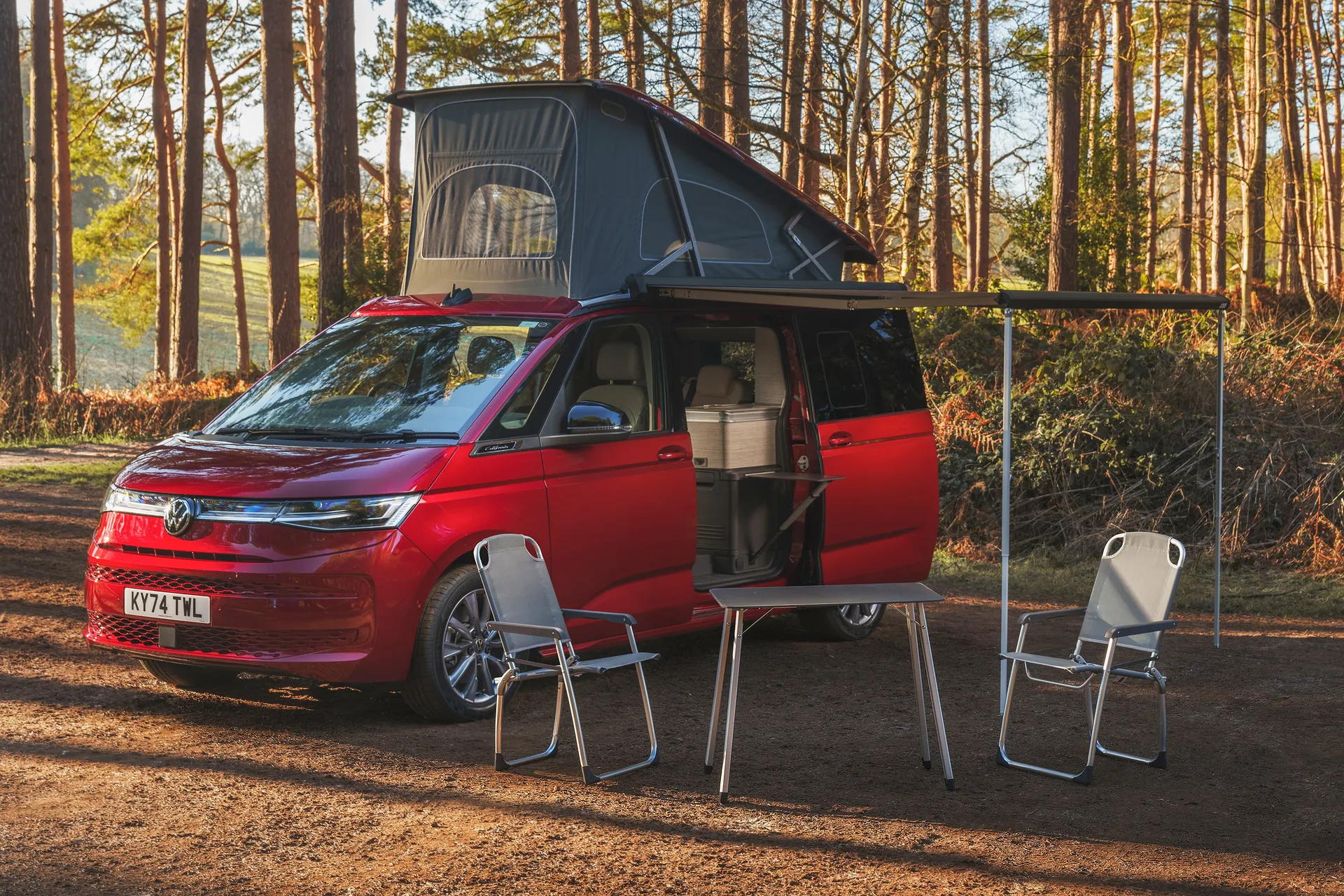
Volkswagen has become synonymous with campervans, so when a new one arrives, it's a big deal. And that's what we have here - the new Volkswagen California. Badged the T7, it replaces the hugely popular T6 California, but rather than more of the same, there have been some big changes.
The biggest one is that this California is no longer based on a van. While the T6 California was closely related to the VW Transporter panel van, the T7 California is based on the long-wheelbase Multivan, which itself is based on VW's car platform. As such, the styling is quite a departure from previous models - some might prefer the more stocky design of the California, but in the right colour and wheel combination, the new T7 California does look the part. Speaking of which, the California offers 11 single-tone paint finishes and a plethora of fancy two-tone paint options as well, aping classic VW Campers, including things like Mono Silver and Energetic Orange, Deep Black Pearl and Fontana Red, and Candy White with Solid Blue Metallic. It doesn't stop there as the pop-up roof can be had in three colours – Toffee Brown, Glacier Bleu and Basalt Grey.
The new Multivan platform has allowed Volkswagen to add 269mm to the length of the California compared to the older model, resulting in an all-new take on the classic VW Camper ‘house on wheels’ concept. A headline improvement is the fact it now has dual sliding rear doors, so UK passengers can get in and out on the ‘safe’ side. Older Volkswagen California models only had a rear door on the right-hand side.
The extra sliding door aids practicality too, with the new Volkswagen California now having a kitchen area that can now be used from outside the vehicle, too (at least on Coast and Ocean versions). It is located further back than before, leaving space for an opening to get in and out.
As before, there are three versions of the Volkswagen California available. The entry-level model is the California Beach Camper and has a mini kitchen in the boot and forgoes a lot of the storage options inside in favour of a third seat in the back. With seating for five and space for four to sleep, it means someone will need a tent...
Upgrade to the California Coast and you'll get the upgraded kitchen with an outdoor folding table. The pop-up roof now comes up with a push of the button, there are better thermal blinds for the driver's compartment, an outdoor shower connection and two additional camping batteries. It seats and sleeps four.
The top-of-the-range California is the Ocean is another notable set up in the luxury stakes - inside and you'll find fancy ambient lighting, available in 30 colours, and there's extra lighting for the pop-up roof, the boot lid and around the kitchen cupboard, as well as by the sliding door. The kitchen inside is further upgraded, and there's a roof storage box, while the front seats are heated for those chilly camping trips.
Joining the diesel engine offering for the T7 California is a 2.0-litre petrol and plug-in hybrid option, though we'd still favour the diesel if we had the choice. More on that further down the review, but to drive and it's not intimidating at all - it's a very similar driving experience to a car, and while you will notice its size, its high driving position and good visibility make threading it along narrower roads easier than you might expect.
Looking for a campervan for sale? We've got 100s of Volkswagen Approved Used Cars for Sale for you to choose from, including a wide range of VW California vans campervans for sale.
Is the Volkswagen California right for you?
Why buy a Volkswagen California over a converted van? While there are a lot of great conversions out there that suit a lot of people's needs (and budgets), you're paying a premium for the California's excellent in-house camping solutions that have all been neatly integrated into the design from the get-go.
It's not just the attention to detail you're paying for, but the quality of finish and the peace-of-mind that comes with VW's 5+ Promise, including a five-year warranty. That's not forgetting how well Californias hold their value on the used market.
If you're looking for a small and well-equipped campervan, then the latest Volkswagen California still sets a high bar by which others are judged.
What's the best Volkswagen California model/engine to choose?
Available across the range, we'd pick the 150PS diesel engine as it offers the best mix of fuel efficiency and performance, while it's also the most affordable choice.
The entry-level Beach Camper might be the one to go for if you want a more stripped-back camping experience, with the interior not too far removed from a Multivan. It does have the largest 'ground floor' bed of the three, and rather than stinking out your living space when cooking, you might favour the rear kitchen set-up. All you really need is an additional fridge (and there's lots of choice) and you're sorted.
It's the top-of-the-line Ocean model that's likely to prove the most popular, though, and it's easy to see why. Decked out in plenty of kit and offering a bit more luxury than the mid-tier Coast, we wouldn't blame you for paying a bit of a premium for the California Ocean, it is going to be your home-from-home after all.
What other cars are similar to the Volkswagen California?
Direct rivals to the Volkswagen California are pretty limited, with only a few manufacturers electing to offer an in-house campervan, though there are numerous camper conversion companies out there that can kit out a suitable van.
Back to manufacturer rivals, and the closest two are the even posher Mercedes-Benz Marco Polo and the Ford Transit Custom Nugget. You'll be able to find a good selection of used examples, but both have recently been updated, with prices and specs still to be confirmed.
A new entrant is the Citroen Holidays - no, the French brand hasn't gone into cheap package holidays, but rather it's its first stab at making a campervan. Based on the Citroen Dispatch van, a new one will set you back less than a three-year-old California.
Comfort and design: Volkswagen California interior
"The front seats are some of the best you'll find on a car (or van), while the thoughtful design of the California means you'll be able to a decent night's sleep once parked up."
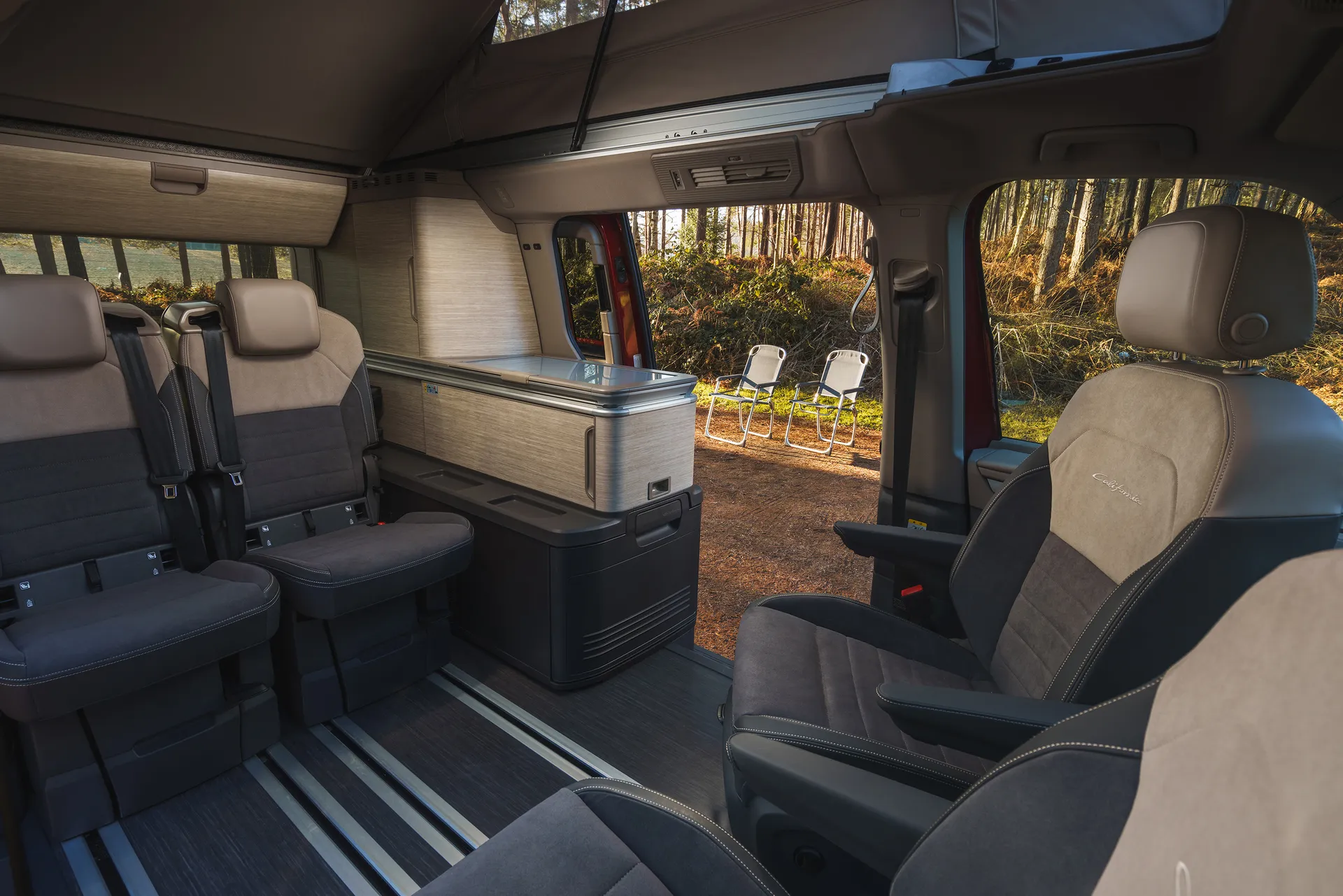
The comfortable front seats with supportive armrests easily swivel round to face into the cabin once parked up, and if you want more headroom during the day, pop the roof up and you can then pop the 'ceiling' up so it's easy to stand in the back. Thanks to the California's extra-large windows, including a panoramic-style windscreen, it can feel really airy inside.
Come nighttime, and you'll want the blackout blinds in place - there are two that magnetically snap to the front two windows, and a larger one that you have to position across the windscreen and use the sun visor to keep it in place. We've only used the 'thermo' blackout blinds on the Ocean and Coast, but they do the job, while other windows have neat roller blinds that can be pulled out and clicked into place.
The beds are pretty easy to set up as well - fold out the rear seats and pull the mattress out, and you've got one bed, with the pop-up roof containing the second one - the modest width of each means that it can be pretty snug. The lower mattress is thicker, but the top one sits on plastic springs - it depends on how well you sleep, but we found them to be a little firm but more than adequate for a couple of nights away. You might want to think about a compact self-inflating mattress if you want a little more comfort.
Access to the top sleeping is via a hole in the roof and requires using the front chairs as a sort of ladder to get in and out. Kids will love it.
Quality and finish
We tested the top-spec California Ocean and the overall finish is very good - though you'd hope that would be the case at the price.
Up front and the move from Transporter to Multivan platform brings a much less workmanlike feel (though to be fair, the T6.1 California did make an effort to disguise its van heritage, we some more premium materials). It all just feels a little more refined, and while it's not a luxurious as a Mercedes Marco Polo, you'll still find plenty of soft-touch materials.
Moving further back and the cabinets and fittings all give the impression that that'll withstand regular use - all slide smoothly or snap shut, though you might need to be careful what you put on the frosted glass cover for the hob and sink. The slick lighting helps as well - there's a really nice gentle strip light running along the kitchen area, while the other lights and the ability to set the brightness can really make it feel cosy at nighttime.
Our Ocean Cali was cloaked in what VW calls 'Frizo Sandwick' for the upper cupboards - the light wood-effect looks slick and elevates it above the flat finish of the Coast, which is finished in 'Platin Sandwick'. Both the Coast and Ocean have what VW calls 'Platin Raven for the lower cupboards and the flooring is in 'Frizo Raven', with all three subtle tones working nicely together.
VW hasn't skimped on the kit either - look closely and the fridge is made by posh camping brand Dometic, while the table and collapsible chairs feel really well made as well.
Infotainment: Touchscreen, USB, nav and stereo in the Volkswagen California
Regardless of which of the three trims you decide on, all get a digital instrument display and a 10-inch infotainment touchscreen. Trouble is, it doesn't use VW's latest operating system, so it's not as slick as the current version, which can make it feel a little clunky to use. And don't even get us started on the touch-sensitive sliders just below the touchscreen to control volume and temperature - they don't light up and night, so it takes a bit of guesswork to discover where they are. Helpful.
Next to the 10-inch display are controls for the automatic sliding doors (if optioned) and pop-up roof, among other things, and while the doors opened and closed on a single press, the roof took a good couple of jabs to instigate a response.
Apple CarPlay and Android Auto is standard, while there is no shortage of USB-C connections on whichever trim you choose.
The California Ocean and Coast come with a new 5-inch van control unit that's located in the C-pillar of the vehicle. Here you can access the California's camping features, including fresh water and wastewater levels, interior lighting functions, power supply status, cool box controls, and the auxiliary heater. There's even a dedicated camping mode that will deactivate the external lights when the camper
is opened and closed on a campsite. It's all nice and easy to navigate, but it can be a little unresponsive at times - you might want to use the dedicated California app that comes with the same functionality.
Space and practicality: Volkswagen California boot space
The new Volkswagen California is a bit longer than the older model, now measuring over five metres at 5,173mm, while it's 2,252mm wide (including mirrors), making it just a bit narrower than the T6.1. Crucially it's still a smidge under two metres tall at 1,972mm - you'll certainly take a sharp intake of breath when going underneath parking barriers, but it should fit...
A California is a big investment, so if you're looking to use it more regularly, you can. Both the Ocean and Coast come with two rear seats with ISOFIX fittings, so it can be used as a family car if need be. Even more practical is the California Beach, which comes with a third seat in the back, but the trade-off is not much in the way of storage space, while you can still only sleep four.
The seats also move independently, so you can tailor the space to suit you, while each one can be removed if desired. Each seat has a storage compartment, but it loses out compared to the large storage compartment on the rear bench seat found in the T6.1 California.
With sliding doors on either side, it does make it a bit more versatile, especially if you're using it more regularly than just camping. A couple of observations if you have the button operated sliding doors - children will invariably lean on the button and trigger the door to close (not very helpful if you have the mini table set up), and the beep when you open the door isn't going to go down well with your campsite neighbours if you get up for a midnight wee.
The compromise with two sliding doors is that you're now down to one gas cooking hob, rather than two in the older model. Is it a big deal? For most potential buyers, the extra flexibility will win out over an extra hob. Anyway, you should be cooking outside and not stinking out your van.
Around the back and both the Ocean and Coast models have hefty boots. The design of the bed means it's split in half, but there's ample space underneath for luggage and camping stuff, while there's more behind the seats. Just remember that if you stack it high, it all has to go somewhere if there are four of you sleeping. Boot space is a little different in the Beach, with the pull-out outside kitchen packed away here, though there's still space for other luggage.
The fold-out table is neatly tucked away underneath the bed at the back, while the two camping chairs are stowed away in the boot door. Elsewhere and you'll find a window-mounted storage solution (ideal for clothes and other stuff), while there are plenty of cupboards in the Coast and Ocean.
What else? There's a roll-out awning that sits on the left side of your camper, though it can be specified to be positioned on the right if you prefer. If you're camping in colder months, then the heater will heat the California in a matter of minutes, while there's an external power inlet on the left rear so it can be hooked up to a local electricity supply and avoid draining the van's battery. There’s a fresh-water tank and another waste tank, and space for a natural gas canister to power the hob.
Handling and ride quality: What is the Volkswagen California like to drive?
"The move from Transporter to Multivan platform has definitely helped the California, delivering a relaxed and comfortable drive."
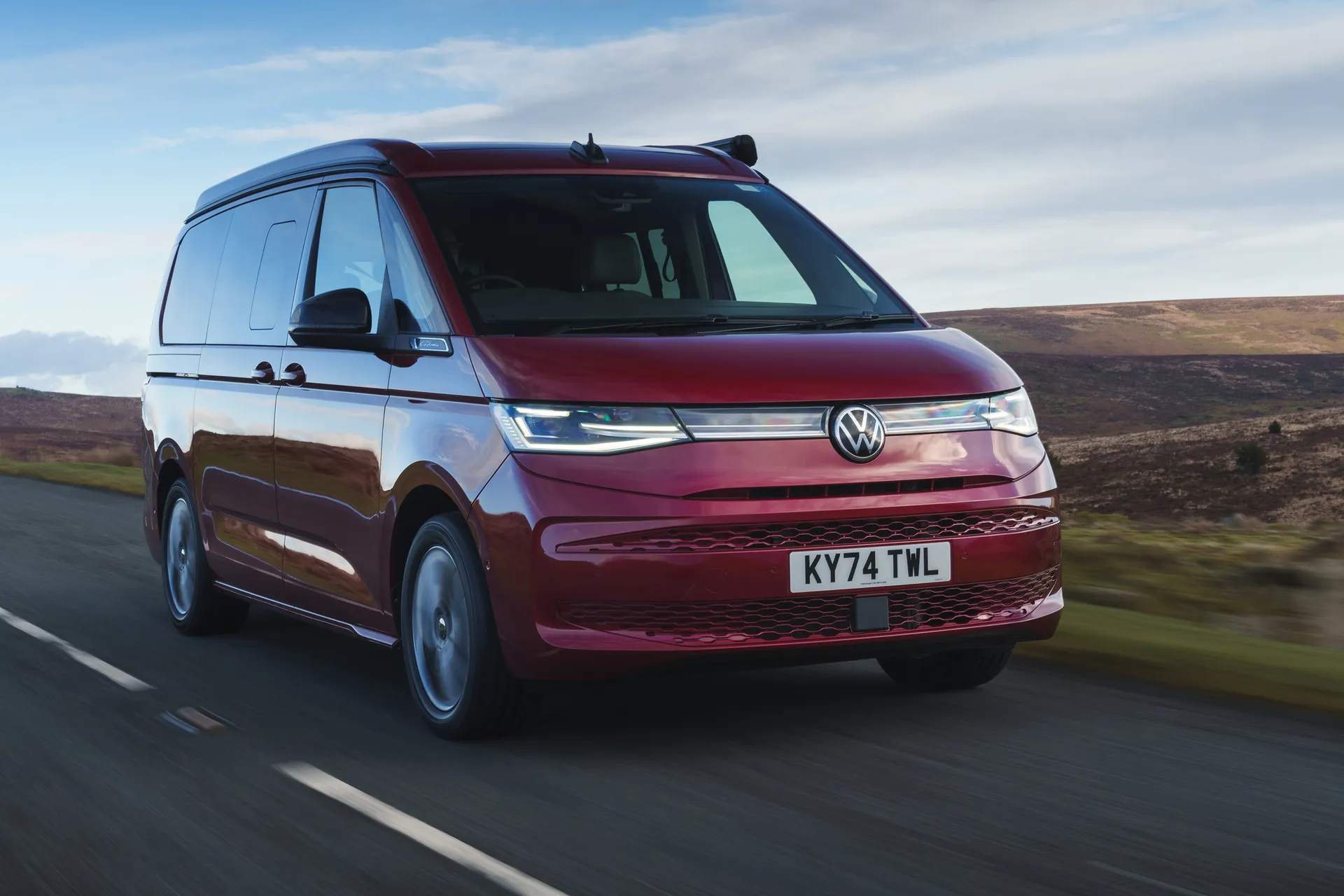
It may be on a more car-oriented platform, but that hasn't stopped the California from delivering a pleasingly high driving position with good all-around visibility. The elevated driving position is complemented by the captain's chairs in the front that still remain comfy after hours on the road. A rear parking camera is standard on Coast and Ocean trims, but an optional extra on the Beach Camper and one we'd be tempted to tick, however.
Fully loaded and thanks to the top-heavy nature of the California, it means you have to be a little bit cautious approaching roundabouts and some corners, but it would be unreasonable to expect it to feel more agile than this when you consider the size and weight of it. What you will find is that the steering is nice and precise, and not too heavy - it's certainly not an intimidating thing to drive if this is going to be your first time driving something this large.
As we've found with the Multivan, the ride can be a little firm on some surfaces, but it doesn't detract from the overall feel of the California - it's really settled at high speed, allowing you to cover some big distances with ease.
What engines and gearboxes are available in the Volkswagen California?
The Volkswagen California comes with the choice of three engines - a diesel, petrol and plug-in hybrid, all paired with an automatic gearbox.
Existing owners will be familiar with the 150PS 2.0-litre diesel, as it found its way into the majority of T6.1 Californias, and for good reason. This frugal engine is at home on long drives, while the lowdown torque sees it get up to speed relatively easily, taking 12.6 seconds to hit 62mph. The 204PS 2.0-litre petrol is more refined and a shade quicker, taking 10 seconds to get to 62mph, but the trade-off here is that it won't be as efficient as the diesel. With higher running costs and steeper asking price, you've really got to have something against diesels to favour the petrol.
That just leaves the new PHEV offering, badged eHybrid. This sees a 1.5-litre petrol engine that's linked up to a battery and electric motor to deliver a combined power out of 245PS and delivering power to all four wheels. Perhaps most importantly, though, is the 56 miles of electric-only range it provides, which, if your campsite isn't too far away, should help reduce fuel costs.
Refinement and noise levels
The new California is nice and refined. As touched on, we've only driven the petrol engine and its only under heavy acceleration that it really makes its presence known. We'd anticipate the diesel to be a bit more vocal, while the PHEV should be quieter still, but only while it has some charge.
In general driving situations, you won't notice much road noise at all, but it's no surprise to discover that wind noise becomes more pronounced when you move onto the motorway. That said, it's not to the extent that it becomes a distraction.
There doesn't appear to be any creaks or rattles from the cabinets and other fittings either, though anything that's left loose will rattle, but that's not something unique to the California.
Safety equipment: How safe is the Volkswagen California?
The amount of safety kit as standard on the new VW California is a step up from the outgoing T6.1. This includes front assist autonomous emergency braking with pedestrian and cyclist detection, lane assist departure warning, swerve support, adaptive cruise control, front and rear parking sensors and numerous airbags for both the driver and other occupants. It might hamper space and storage when it comes to camping, but the two rear seats (or three on the Beach Camper) have ISOFIX fittings for child seats.
The latest VW California hasn't been crash tested yet, but the closely related Multivan scored a full five stars in the Euro NCAP safety test when tested a few years ago.
MPG and fuel costs: What does a Volkswagen California cost to run?
"If fuel efficiency is a key concern, then you'll want to look at first at the diesel option, which claims an average economy of around 41mpg."
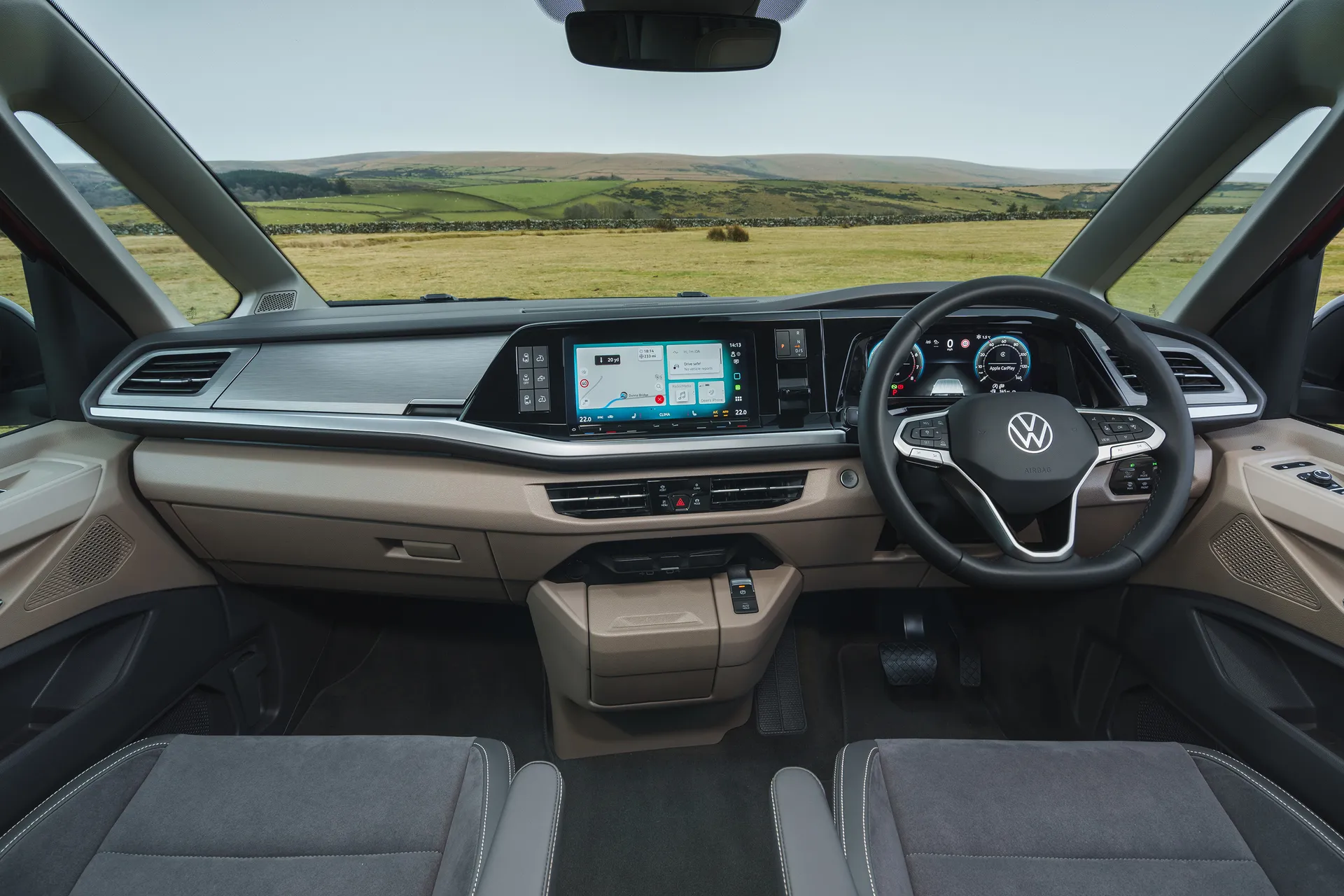
As you'd expect, the more powerful petrol engine lags behind, with a combined average of 30mpg, though on a 100-mile trip that took in the M25, A roads and slower B roads, we managed just over 33mpg.
The California eHybrid 4Motion has a range of up to 54 miles on battery power alone, so a combined MPG of 299 is possible, but to get anywhere near that, you'll need to have the battery constantly topped up. Run the battery down and rely on the engine alone, and you'll be lucky to achieve similar figures to the standard petrol California.
Volkswagen California reliability and warranty
With the California based on the same MQB platform as the Multivan, it should prove to be a dependable option, and to back this up, VW is currently selling the California with what it calls its 5+ Promise. This includes five services, three MOTs, a five-year warranty (or 124,000 miles) and five years roadside assistance from the AA.
Volkswagen California insurance groups and costs
Insurance groups for the new VW California are still to be defined, but expect them to be in the low to mid 30s if the previous generation model was anything to go by.
One thing to bear in mind is that there are specialist insurance companies out there for campervans that can help drive premiums down as opposed to simply sticking with a more mainstream car or van insurance broker.
VED car tax: What is the annual road tax on a Volkswagen California?
After the first year, tax is set at £195, but because the Volkswagen California starts at well over £40,000, the Expensive Car Supplement becomes applicable. This means that an additional £425 a year on top of the road tax bill between years two to six, bringing the annual total to £620.
Volkswagen California price
"Prices for the new Volkswagen California start at £63,481 for the Beach Camper with a diesel engine, rising to over £77,000 for the premium Ocean trim."
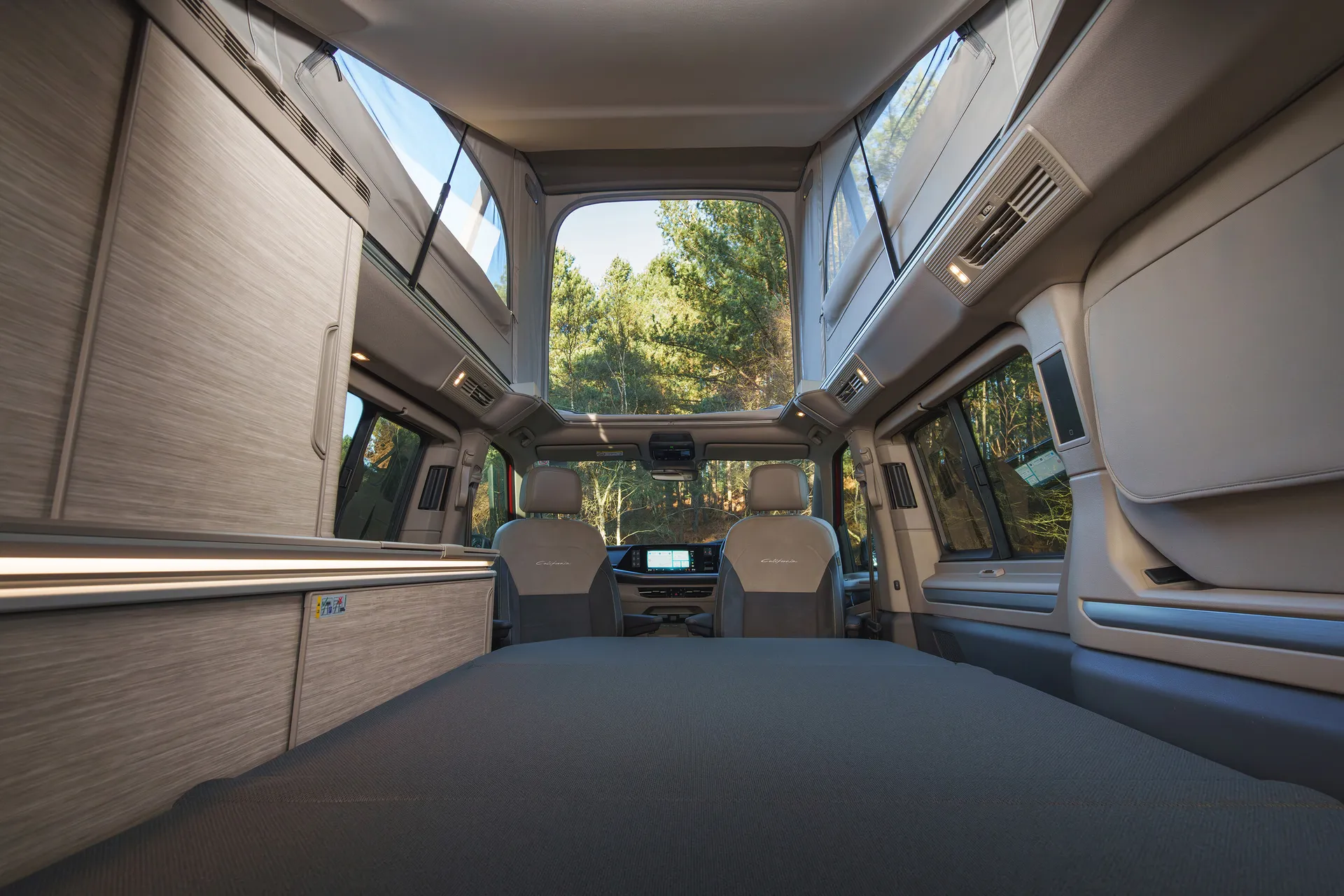
Both the California Coast and Ocean are available with the more refined but less efficient petrol engine, which adds a premium of just under £3,000 and pushing the Ocean over £80,000. The four-wheel-drive PHEV version is another £5,000 or so more than the petrol and is available on all three trims.
It doesn't stop there, however, as there are a number of accessories and extras you can add on to your California, including things like a towbar and the desirable two-tone paint finish.
This makes rivals like the Citroen Holiday look like a bargain at £56,000, but Californias are notoriously good at holding their value - you just have to look at the used market to see even three-year-old high-spec models not dipping much below £60,000. Meanwhile, prices for the new Ford Transit Custom Nugget and Mercedes Marco Polo are still to be revealed, but if both follow the previous generation, then they're likely to set you back more than a California.
Trim levels and standard equipment
You have the choice of three trims with the new Volkswagen California T7 - Beach Camper, Coast and top of the range Ocean.
The first run on the California ladder is the Beach Camper. Sitting on rather small 16-inch alloy wheels (and it doesn't appear you can upgrade these on the configurator), the California Beach Camper features 65% darkened windows in the passenger compartment and an awning on the left-hand side. There's a manual pop-up roof that comes with three windows and a front opening, while it's the only VW California T7 that comes with three rear single seats. We'll get to driver tech and infotainment in a minute, but first, let's break down the camping kit included. There's a 230-volt inlet with charging feature, an external 230 volt power input socket, and a three-pin socket in the interior, while there's a camper control unit in the C-pillar.
The California Beach Camper has the largest lower bed of the range at 1,980 x 1,330mm, with a 200kg load capacity, while the rooftop bed measures 2,054 x 1,137mm, again with a 200kg load capacity. There's an interior blackout system to keep the light out (and to stop people looking in), though the rear window and two sliding doors have roller blinds. Around the back is a fold-out mini kitchen with a 1-burner gas cooker and technical box with additional battery and a 230-volt outlet. If you're camping in colder conditions, there's a fuel-fired parking heater and a fuel-powered auxiliary heater. And we can't forget the two fold out chairs and table.
Other features included in the Beach Camper are a 10-inch infotainment screen, two USB-C ports at the front and four more in the back. Manual air conditioning and an auxiliary heater for the passenger compartment are bundled in, while the VW California comes with a wealth of driver assistance tech, including adaptive cruise control, Dynamic headlight range control, 'Front Assist' autonomous emergency braking with pedestrian and cyclist detection, front and rear parking sensors, LED main headlights and tail lights.
Moving up to the middle of the range VW California Coast and it now sits on larger 17-inch alloy wheels, while camping kit gains a second and third battery with LV voltage converter, a folding lower bed that measures 1,980mm x 1,080mm, thermo blackout blinds, a stowage bag between the right-hand C- and D-pillar, a kitchenette with sink, gas nob and pull out fridge. The pop-up roof now pops up with the press of a button, while there's also a versatile folding table and an outdoor cold shower. When it comes to driver assistance tech, perhaps the most notable addition is a rear-view camera.
Finally, the top-spec VW California Ocean. Coming on 18-inch alloy wheels, luxury takes a bit of a step up with things like front heated seats, some nicer cupboard finishes and seat covers, LED Matrix lighting, sliding doors with a power latching system and Travel Assist as standard.
Ask the heycar experts: common questions
Does the Volkswagen California have a toilet?
Do Volkswagen Californias hold their value?
Can you stand up in a Volkswagen California?
Get our latest advice, news and offers
Keep me updated by email with the latest advice, news and offers from heycar.
By submitting you agree to our privacy policy
